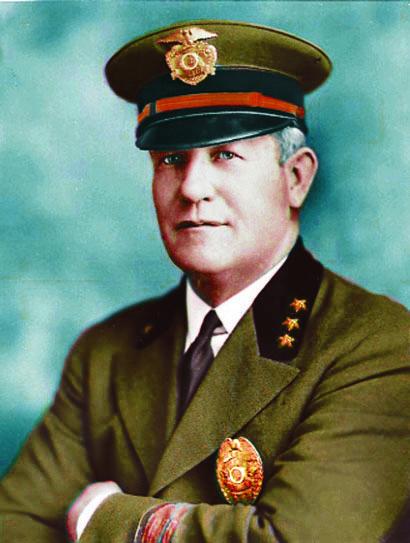
Because of the growth, Patrick found himself asking the council to appropriate money for patrol cars and a telephone system. Detectives already had a car for investigations, and there were two patrol wagons/ambulances, but there was nothing that would today be considered a regular patrol car.
By 1922 it was obvious that needed to change. Officers assigned to outlying areas were still using bicycles, horses or walking, while many criminals were now behind the wheel. Faced with a budget that simply would not allow the purchase of a fleet of police cars, Patrick suggested to the council that officers purchase their own cars to drive on duty. In return, the department would provide the officer with an allowance for the upkeep of the vehicle. The council quickly agreed. The requirements for the vehicles were fairly simple; the vehicle just had to be fast and easily serviceable.
The telephone request wasn’t entirely new. There had been a phone in the station for years but it was not part of any formal communications system nor was the number widely known. When the first formal phone was established, the number was Franklin 1101 and it was the direct line to the duty sergeant’s desk. The single phone would become the backbone of police communications until another one was installed in the chiefs’ office in 1925. Years later, a separate office to handle calls for service would be established. Called the Business Office, it would later become the police Communications Division.
In 1923 Patrick brought the city lifeguards onto the police department. The first chief lifeguard, Spade Burns, supervised a small team of men and worked out of the La Jolla substation.
Chief Patricks good work did not go unnoticed. As chiefs were still serving two year terms, having the mayors support earned him several nominations for reappointment.
If the 19th century could be called the century of new city charters, then the 20th century was starting to look as though it would be the century of new badges. In 1925 another new badge was introduced. In keeping with the tradition of silver, the new badge was shield shaped and more resembled an east coast style than one that might be thought of in San Diego. The badge style was also short lived and was gone by 1930.
Patrick’s modernization of the department was easy compared to what else the SDPD would face - prohibition. Also known as the Volstead Act, Prohibition made possession, manufacture and sales of alcoholic beverages illegal throughout the United States. In major cities around the United States, street gangs, who had almost been put completely out of business in the early 1900’s, were now coming back in full force to satisfy a thirsty nation.
With San Diego a border town, it didn’t make sense for street gangs to fight for turf to control alcohol sales. Not when someone who wanted a drink could simply drive into Mexico. San Diego’s problem would be smuggling. On many occasions San Diego law enforcement officers would stop a car loaded with alcohol coming back across the border. It would be a testament to their integrity that few officers were prosecuted for looking the other way to the activity.
In 1927 a new Mayor was elected and with Patrick having received support from the past administration, on May 31st, he chose to step down rather than risk being fired. His resignation as chief didn’t mean the end of his police career. He reverted to the rank of lieutenant and was assigned to work as assistant chief. His eight years at the top were the longest of any chief up until then.
James Patrick was an US Army veteran of 14 years having served in the Spanish-American War and all over the South Pacific before he took a wife only to decide the military life wasn’t conducive to marriage. With that he bought his discharge and came to San Diego where he was hired by Keno Wilson on January 15, 1912. It was also Wilson who promoted Patrick to both sergeant and lieutenant.
With Steward McMullen’s firing, Patrick was the obvious choice to become the next permanent chief. This time the council had learned outsiders were simply unable to run the department and were willing to back off a bit and give the new chief some breathing room.
Shortly after taking office, one of his first acts was to reappoint Keno Wilson as a sergeant. Next came the more difficult task of trying to modernize the SDPD to keep up with a very rapidly changing city.
When Patrick took office, the city’s population stood at less than 75,000 people. Ten years later it had almost doubled. As a result, the department was struggling to keep up. It was also during the 1920’s that the city saw the construction of 10 military bases. San Diego was quickly becoming a major armed forces hub.
THE THIN BLUE LINE

CHIEF JAMES A. PATRICK
SDPD 05/04/1917 - 10/09/1917 & 04/19/1919 - 05/31/1927
& 08/04/1931 - 08/25/1931
01/07/1881 - 01/16/1960
PRE 1930
POST 1930
